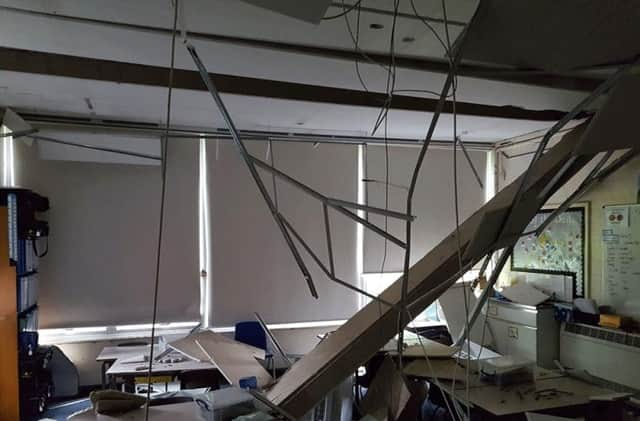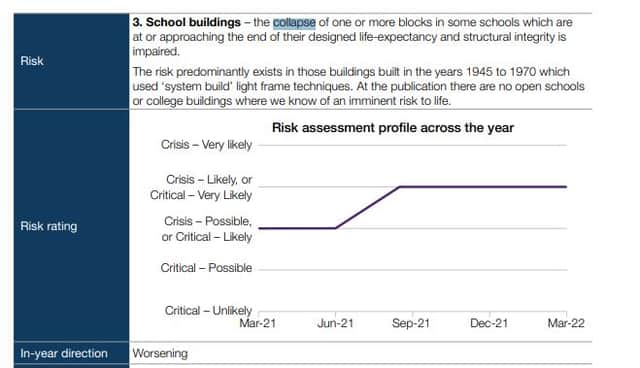School RAAC closures: government’s own risk level said in 2021 it was ‘very likely’ buildings will collapse
and live on Freeview channel 276
Schools have been ordered to close buildings just days before the start of term - however it has emerged that the government raised the risk level of collapse to “critical - very likely” two years ago.
The Department for Education’s annual report, from December, revealed that in September 2021 the risk level of buildings collapsing was upgraded to “crisis - likely, critical - very likely”, the second highest level of warning.
Advertisement
Hide AdAdvertisement
Hide AdIt said that “there is a risk of collapse of one or more blocks in some schools which are at, or approaching, the end of their designed life expectancy, and structural integrity is impaired”.
It comes after the government revealed it is contacting more than 100 schools across England, just days before the start of term, warning them not to use certain buildings containing reinforced autoclaved aerated concrete (RAAC). In some cases, entire schools may not be able to open.
This type of concrete, which was used as a common building material from the 50s until the 80s, is reportedly “prone to collapse”. Schools minister Nick Gibb said the government has been liaising with schools for some time over the risks of RAAC, and this decision was only made after “a change in information”.


However unions and industry groups say they have been warning the Department for Education since 2018 over concerns around the safety of school buildings.
Advertisement
Hide AdAdvertisement
Hide AdCllr Kevin Bentley, senior vice-chairman of the Local Government Association, said: “Leaving this announcement until near the end of the summer holidays, rather than at the beginning, has left schools and councils with very little time to make urgent rearrangements and minimise disruption to classroom learning.
“The LGA has been warning of the risk from RAAC in schools since 2018. The government should urgently establish a taskforce, including with the LGA and councils to ensure the safety of both pupils and staff in the long term.”
Thirteen national education associations wrote to every Conservative MP in October last year warning about funding, saying they were concerned about the 2,000 schools which contained RAAC. At the time, they warned that these roofs are prone to collapse.
And in February, the Royal Institute of British Architects (RIBA) along with seven unions wrote to the DfE urging it to disclose which school buildings are most at risk and have an urgent intervention.


Advertisement
Hide AdAdvertisement
Hide AdPaul Whiteman, general secretary of the main headteachers' union NAHT, said about the letter: “This is a disaster waiting to happen, which in the worst-case scenario could end up costing lives unless the government wakes up and acts.”
A report in June by the National Audit Office (NAO) said that the risk of injury or death from a school building collapse in England was “very likely” - as it warned of the “critical” danger to pupils and staff.
And now it has emerged that the government’s own risk level was upgraded to “crisis – likely or critical – very likely” in September 2021.
Published in December 2022, the report said: “There is a risk of collapse of one or more blocks in some schools which are at or approaching the end of their designed life-expectancy and structural integrity is impaired.
Advertisement
Hide AdAdvertisement
Hide Ad“The risk predominantly exists in those buildings built in the years 1945 to 1970 which used ‘system build’ light frame techniques. At the publication there are no open schools or college buildings where we know of an imminent risk to life.”
At the time, Labour called for the government to publish a list of schools and buildings at risk - something which it has still not done following the latest announcement.


The Schools minister Nick Gibb said since 2022 the government has been surveying schools which have RAAC. He said that before yesterday, the DfE had been working with 52 schools, where the dangerous concrete was thought to be in a “critical condition” and put in place alternative accommodation.
Gibb said that over the summer the government learned that schools where RAAC had previously been declared as non critical were actually unsafe, which led to the decision to block the use of buildings yesterday.
Advertisement
Hide AdAdvertisement
Hide AdHe told the Today Programme: “We were looking at the evidence, we had to discuss the evidence with experts. It is a big decision to take. This evidence could have emerged in say November right in the middle of term time, so it’s just a coincidence that it emerged now.”
The government’s education hub blog states: “The government has been aware of public sector buildings that contain RAAC since 1994 and we have been monitoring their condition since 2018. We continually assess new information and research about RAAC to ensure the safety of schools and pupils.
“In 2022, the Department for Education sent a questionnaire to all responsible bodies, asking them to provide information to help us understand the use of RAAC across the school estate and make sure the correct support is in place.
“Recent cases have now changed our assessment of the risk that RAAC poses to building safety. We are taking immediate steps to ensure the safety of staff and pupils in line with this.”
Comment Guidelines
National World encourages reader discussion on our stories. User feedback, insights and back-and-forth exchanges add a rich layer of context to reporting. Please review our Community Guidelines before commenting.
